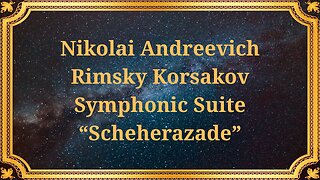Premium Only Content

Wolfgang Amadeus Mozart Trio №1 In G Major For Violin, Cello And Piano, K 496
#classicalmusic #WolfgangAmadeusMozart #TrioNo1 #GMajor #Violin #Cello #Piano #MusicalComposition #MozartTrio #ClassicalComposers #MusicHistory #ClassicalEnsemble #ChamberMusic #MozartInfluence #MozartLegacy #MusicPerformance #MozartTrioNo1
Jean Fournier; Antonio Janigro; Paul Badura-Skoda;
Wolfgang Amadeus Mozart, a musical genius of the Classical era, left an enduring mark on the world of music through his exceptional compositions. Among his vast repertoire, Mozart's Trio No. 1 in G Major for Violin, Cello, and Piano, K 496, stands as a testament to his exquisite talent.
Composed in 1786, during a period of tremendous productivity for Mozart, Trio No. 1 in G Major reflects the elegance and refinement of the Classical era. Mozart, known for his prodigious talent and remarkable musicality, played a pivotal role in shaping the musical landscape of his time. This era witnessed a shift from the complex Baroque style to a more balanced and structured approach characterized by clarity, grace, and emotional depth.
Mozart's Trio No. 1 in G Major is a testament to his mastery of chamber music. It consists of four movements - Allegro, Andante, Menuetto, and Rondo: Allegretto. The opening Allegro immediately captivates the listener with its joyful and energetic melodies, showcasing Mozart's gift for crafting memorable musical themes. The Andante, a lyrical and expressive movement, provides moments of introspection and emotional depth. The Menuetto, a graceful dance-like movement, offers a delightful contrast. The finale, Rondo: Allegretto, concludes the trio with its lively and spirited character, featuring virtuosic passages and playful interplay between the instruments.
In this trio, Mozart skillfully balances the roles of the violin, cello, and piano. The violin takes the lead in carrying the melodic lines, showcasing its brilliance and expressiveness. The cello provides a rich and resonant bassline, adding depth to the ensemble. The piano, a versatile instrument, acts as both a harmonic support and a solo voice, demonstrating Mozart's command of writing for the keyboard. The interplay between the three instruments creates a harmonious and cohesive ensemble, with each instrument contributing to the musical narrative.
Mozart's Trio No. 1 in G Major continues to captivate audiences and musicians alike with its timeless beauty and exquisite musicality. Its melodic charm, technical brilliance, and meticulous compositional structure have ensured its place among the chamber music repertoire. This composition not only showcases Mozart's exceptional talent, but it also represents the pinnacle of the Classical style.
The Trio No. 1 in G Major remains a testament to Mozart's enduring influence on the world of music. Its enduring appeal and widespread popularity have made it a staple of concert halls and chamber music ensembles. This composition stands as a testament to Mozart's genius and his ability to create music that transcends time and resonates with listeners.
Conclusion:
Wolfgang Amadeus Mozart's Trio No. 1 in G Major for Violin, Cello, and Piano, K 496, stands as a testament to his unparalleled musical brilliance. Its historical significance, enchanting musical characteristics, and enduring appeal make it a cherished composition in the chamber music repertoire. Through this trio, Mozart's genius shines brightly, leaving us in awe of his ability to create captivating and timeless music. The Trio No. 1 in G Major continues to inspire and delight listeners, reminding us of the everlasting beauty and power of classical music.
You have the opportunity to support the channel:
https://destream.net/live/RadSiarAl/donate
https://www.buymeacoffee.com/6355radsiaral
-
 41:38
41:38
Classical music_Music Inspiration
1 month agoNikolai Andreevich Rimsky Korsakov Symphonic Suite “Scheherazade”
1721 -
 3:09:10
3:09:10
Barry Cunningham
9 hours agoPRESIDENT TRUMP HAS TAKEN THE MONSTER AWAY FROM THE LEFT! HORROR STORIES WON'T WORK ANYMORE!
69.6K73 -
 1:29:55
1:29:55
WickedVirtue
4 hours agoLate Night Fortnite w/ Friends
35.5K -
 3:34:06
3:34:06
This is the Ray Gaming
4 hours ago $0.29 earnedCould you be? Would you be? Won't you be my RAYBOR? | Rumble Premium Creator
20.8K -
 1:46:52
1:46:52
JahBlessGames
5 hours ago🎉Come een' and come tru' - VIBES | MUSIC | GAMES
39.5K -
 38:47
38:47
MattMorseTV
7 hours ago $12.09 earned🔴Tulsi just CLEANED HOUSE.🔴
59.2K100 -
 6:24:06
6:24:06
Reolock
8 hours agoWoW Classic Hardcore | WE'RE BACK!!
25.1K1 -
 3:46:13
3:46:13
SynthTrax & DJ Cheezus Livestreams
10 hours agoShell Shock Live - The Scorched Earth Remake/Upgrade - 4pm PST / 7pm EST - RUMBLE GAMING
43.6K -
 2:56:57
2:56:57
Illyes Jr Gaming
6 hours agoBack to Black .....Ops 6 w/ ILLYESJRGAMING
27.8K1 -
 1:07:59
1:07:59
BonginoReport
9 hours agoBoston Mayor Defies Trump, Protects Illegals - Nightly Scroll w/ Hayley Caronia (Ep.115)
128K96